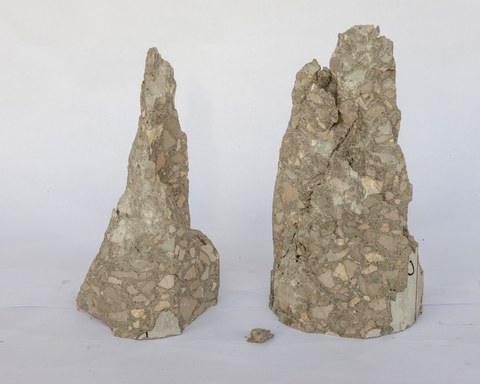Fatigue resistance of different mixtures
Table of contents
Project data
| Titel | Title Ermüdungsuntersuchungen an Betonproben hergestellt aus vier unterschiedlichen Rezepturen | Fatigue tests on concrete specimens made from four different mixture Auftraggeber | Client Firmengruppe Max Bögl, Sengenthal Zeitraum | Period 08/2020 – 06/2023 Projektleiter | Project manager Prof. Dr.-Ing. Steffen Marx Team | Team Raúl Enrique Beltrán Gutiérrez, M. Sc. Dr.-Ing. Torsten Hampel Doreen Sonntag, Heiko Wachtel (test conduction) |
Report from the year book 2022
Does concrete get tired?

Concrete specimen after failure due to cyclic loading
People get exhausted under continuous and repeated physical and mental stress. From the experience of daily life, it can be said that this fatigue is not so much determined by a single event, but by its repetition. Concrete can also fatigue when subjected to alternating stress levels under cyclic loading, even far below the static compressive strength. Understanding this behavior is crucial for assessing the long-term reliability of dynamically loaded structures, such as wind turbines.
In this project, the fatigue resistance under uniaxial compressive swell loading of high-strength concretes of strength classes C100/115 and C80/95 made of different mix compositions is investigated. These are self-compacting, high-strength concretes whose composition is regulated in the corresponding general building approval.
Concrete, cylindrical test specimens were tested under different stress levels. Previous investigations have shown that specimens from the same concrete formulation can exhibit different types of progressive damage development depending on the load level at which they were tested. This is due to the complex phenomena of material degradation, which are influenced by material properties of matrix and contact surface mortar, hardened cement paste, aggregate and pores. The stress levels for the tests were chosen to characterize the behavior of the individual formulations under real loading situations. These stress levels thus represent load cases that could, for example, cause significant fatigue damage on a verification section of a wind turbine.
Based on the test results, the applicability of the fatigue check according to Model Code 1990 or fib Model Code 2010 for the investigated high-strength concretes is tested and evaluated. Furthermore, on the basis of the test results, it is recommended how the design compressive strength under fatigue loads is to be calculated for the investigated concretes.
